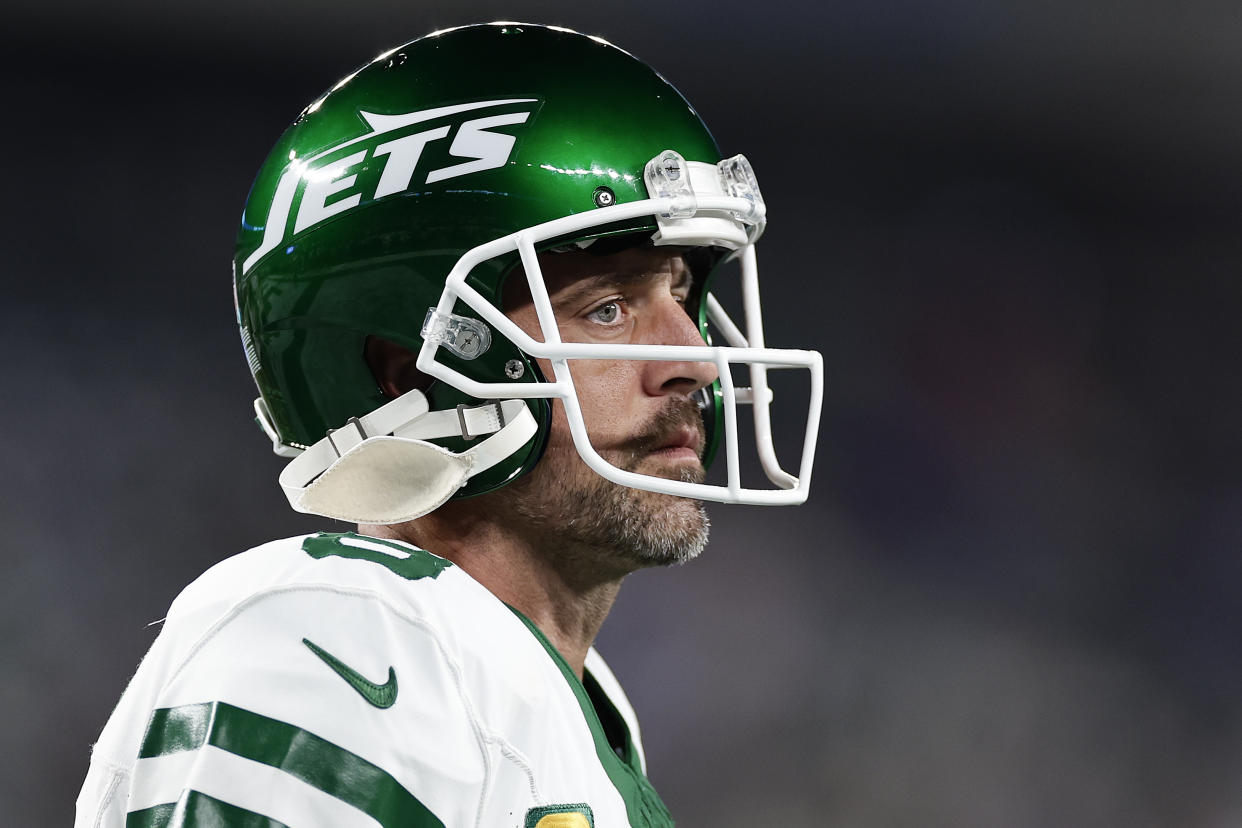Experts say Aaron Rodgers' injury likely isn't career-ending: 'He can be the same type of athlete he was before'
Aaron Rodgers was already asking a lot of his body when he chose to return to a notoriously brutal sport just a few months shy of his 40th birthday.
Now he faces an even tougher challenge fighting back from a devastating injury that has forced much younger players into premature retirement.
Three orthopedic surgeons who specialize in sports medicine told Yahoo Sports that Rodgers will likely need 9-12 months to recover from the torn Achilles tendon he suffered only four snaps into his New York Jets debut on Monday. That timetable would put Rodgers on track to play by the start of the 2024 NFL season, if he decides that’s what he wants to do.
The surgeons didn’t rule out the possibility that the four-time league MVP could approach or even match his previous level of play. Athletes are redefining what’s possible after Achilles tears, thanks to more advanced surgical techniques and more aggressive rehab strategies.
“I’m optimistic that he can be the same type of athlete he was before,” said orthopedic surgeon David McAllister, the UCLA athletic department’s head team physician. “He’s going to have to go through a rough year of a lot of rehabilitation, but if he’s still as motivated and driven as he’s always been, then I think it’s likely he can return at a very high level.”

While the Jets are preparing to have Zach Wilson start at quarterback for the rest of this season, head coach Robert Saleh doesn’t believe Rodgers is ready to retire. Saleh told reporters Wednesday that he’d be “shocked if this is the way he's going to go out."
Rodgers has not yet spoken publicly since his injury, outside of an Instagram post Wednesday, but last month, the 39-year-old said he hoped his tenure with the Jets would “be a few years' partnership.” After considering retirement last spring, Rodgers said the trade to the Jets had reenergized him, and he wanted to keep playing as long as it remained fun and his body felt good.
Now, Rodgers will be missing out on the fun of quarterbacking the long-struggling Jets to their first Super Bowl since 1969. He’ll instead undergo surgery at a yet-to-be-disclosed date and then begin months of grueling rehab.
The purpose of the surgery is to suture the ends of Rodgers’ tendon together in a way that the tension matches that of the quarterback’s other Achilles. Whereas the procedure once required an 8- to 12-centimeter incision in the back of the calf, many surgeons now favor a less invasive technique to reduce healing time and limit the threat of infection and other complications.
Superior suturing techniques have enabled today’s athletes to begin rehabbing earlier without fear of stretching or retearing the surgically repaired tendon. Athletes who once would've immobilized their leg in a cast for 6-8 weeks now waste little time before beginning blood flow restriction therapy and range-of-motion exercises.
“If it’s immobilized 6-to-8 weeks, maybe there's scarring around the tendon, and the athlete’s explosiveness never comes back,” Jason Bariteau, an Atlanta-based foot and ankle specialist, told Yahoo Sports last year. “It's the difference between being an All-Star and making the team. Those little, small percentages are everything.”
Orthopedic surgeons are in agreement that Rodgers’ recovery will take a little longer because of his age. A 39-year-old athlete is likely to have ever-so-slightly less blood flow and elasticity than someone a decade or two younger.
Yet the nature of the quarterback position could work in Rodgers’ favor. While Rodgers has to move around in the pocket to be successful, he doesn’t require the explosive lower-body movement of a gymnast, a basketball player or even a running back.
“I’d rather be a quarterback with an Achilles rupture than a power forward with an Achilles rupture,” said Edward Haupt, an orthopedic surgeon at the Mayo Clinic in Florida.
Part of the challenge of predicting Rodgers’ future is that the sample of NFL quarterbacks who have suffered Achilles tears is small. In fact, two of the most prominent examples occurred long before some of the cutting-edge research and technological advancements of the past decade or two.
Dan Marino has said that the surgery to fix his Achilles “didn’t work the way it was supposed to” when he tore the ligament five games into the 1993 season. Yet the 32-year-old Marino figured out how to adjust by the start of the following regular season, opening a Pro Bowl season with a five-touchdown masterpiece to beat New England.
In 1999, New York Jets quarterback Vinny Testaverde tore his Achilles in the opening game of a promising season, just like Rodgers did nearly a quarter-century later. Testaverde returned the following season but threw a career-high 25 interceptions.
How will Rodgers’ story turn out? Can he recover from a cruel injury and regain his past form? The orthopedic surgeons are hopeful.
“He’s a gifted athlete, he’s going to receive exceptional care, and he’s clearly committed to the game,” former Washington Capitals and Washington Nationals team physician J.R. Rudzki said. “I’m cautiously optimistic that he’ll be able to make a successful comeback.”
